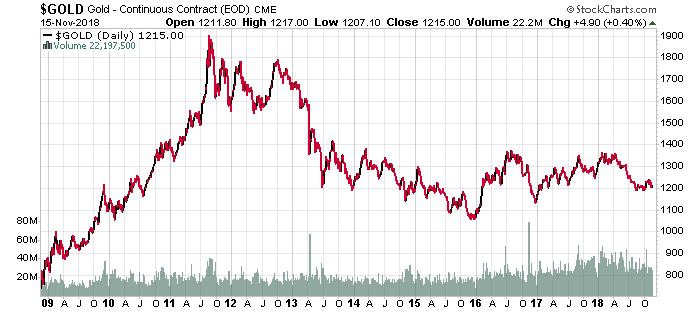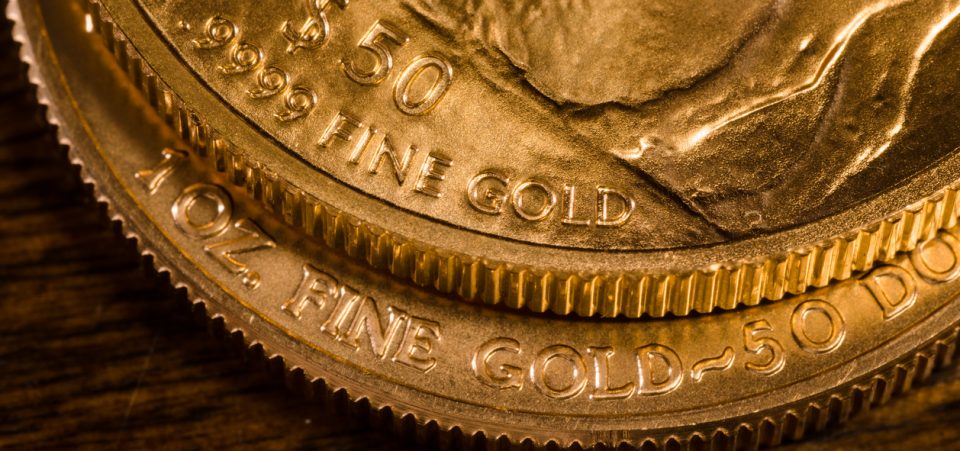Why Does the Gold Price Keep Dropping After Every Bullish Move?
The gold price has shown signs of life over the past few weeks. It has risen and fallen, even going above $1,240 per ounce, only to drop back toward what we can establish as the current floor price of $1,200 per ounce.
Before we consider the basics and analyze the strange fluctuations in the price of gold—by “strange,” read “bearish”—I believe the main problem has a name.
Or better, it has two names: the U.S. dollar and Brexit (and maybe Italy as well).
Gold found some solid support for $1,220 or higher for a few weeks when the euro was catching up, ever so slightly, to the dollar.
Pavlovian Investors
Because many investors these days tend to act according to Pavlovian logic, rather than analysis, they reject gold because the dollar is high. The textbooks say that’s what’s supposed to happen.
But, as usual, reality is more nuanced, and more often than not it breaks the orthodox patterns.
The euro, the dollar, and the gold price now are breaking all patterns. They are establishing new ones because we’re in the midst of a rare and significant shift.
After moving a little higher, the EURUSD exchange rate has moved back in favor of the dollar.
At first supported by apparent progress in the Brexit process, the recent resignations of four ministers from the British government over its controversial Brexit plan sent shockwaves through Westminster. How long before U.K. Prime Minister Theresa May also resigns?
But more significantly, and almost ignored in the myopic news cycle in North America, the increasing isolation of Italy from the European Union—rivaling Greece in 2014—has dealt the euro a severe blow.
And what does all this have to do with the price of gold?
Consider the Euro
The weak euro makes the dollar appear stronger—and in turn, it makes the gold price weaker.
To make matters worse—for gold, that is—the Brexit problems have worsened the outlook for the British pound vis-à-vis the dollar. The expectations now are clearly pointing to the Bank of England postponing its next interest rate hike, while the U.S. Federal Reserve has already made it clear that another hike is coming.
Could it be that many analysts, traders, and investors operating now have never known anything other than near-zero interest rates?
Whatever the reason, such tremendously destabilizing factors as Brexit and Italy’s challenge to the eurozone’s strict austerity rules (and the consternating reaction from the “virtuous” northern states such as Austria and the Netherlands) should have sent the gold price soaring.
Rather, the only thing analysts see is the bullish support—even if only on the surface—of the high U.S. dollar. They don’t see the disruption to the markets, economies, and international relations that is popping up everywhere with increasing frequency.
It’s a case of financial advisors and pundits telling their clients that gold is a silly investment.
A Changing Conception of Safe-Haven Investment
To make matters more interesting, Bitcoin, which purports to be the new safe-haven investment, challenging gold and other precious metals, suffered a major blow as well. It dropped below the $6,600 level for the first time in months, hitting $5,480.
In other words, the idea of a safe haven or a flight to safety has totally escaped from investors’ insect-like (more fly or mosquito than ant) attention spans.
Then again, if most people and institutions heeded warnings, the world would have experienced fewer wars, market crashes, revolutions, and tragic dynamics of all kinds.
Therefore, the silver lining about the current price of gold is that it’s low and appetizing for those who can see beyond the length of their shadows.
The problem, in a wider context, is that the U.S. economy is still the world’s largest economy and the one against which all others compare. So long as it’s perceived to be strong, safe-haven investments will be ignored.
Wait Until 2019 for the Gold Price to Resume Its Function as a Barometer
The real test of gold as an economic barometer will come in January 2019. That’s when the U.S. House of Representatives will switch back to Democratic control in the wake of the midterm elections.
Even though the Senate has become even more Republican, the House promises to put up a fight against President Donald Trump, going after him in more intrusive ways than the FBI/Robert Mueller-led “Russiagate” investigation has.
That, combined with the other international difficulties, should finally persuade investors that the wider political and financial outlook warrants caution. The gold price should start rising in response to lower confidence.
Even then, the price of gold does not fluctuate or shift as easily as stocks. It took a few years and the start of the eurozone crisis to send stock prices soaring in 2010 and 2011—almost two years after the Lehman Brothers Holdings Inc. crash.
The Brexit referendum in 2016 had the British worried and the price of gold rising again, though not as sharply as in 2011.

Chart courtesy of StockCharts.com
Oddly, while Britons were uncertain about the Brexit referendum, producing a bullish effect for gold, they should be even less bullish now. Brexit is a fait accompli, a done deal.
Yet, the struggle to process it and the many evident problems it has generated for Britons should cause more justified concerns.
Instead, if we were to use gold as a barometer of investor sentiment, you’d think everything was great. Well, it’s far from great, and it’s completely uncertain.
Brexit Could Be the Catalyst for Higher Gold Prices
“Brexit,” as Theresa May has stated repeatedly, “means Brexit.”
Yet her deal to leave the European Union has been criticized for leaving too many links to the union unchanged, even as the U.K. loses the ability to influence EU policy.
It’s unclear what Brexit will change and whether it will be for the better. The only certainty is that few voters in the U.K. have cause to celebrate.
If they voted to stay in the EU, they’re disappointed to leave. If they voted to leave, they have grown frustrated with the fact that Britain has not enacted Brexit yet, and that, when it comes, it will be in a diluted form.
The combination of political uncertainty in Washington, London, and Brussels will combine with concerns of rising interest rates. The fact that the European Central Bank will also increase interest rates should provide additional risk.
The gold price has shown that it no longer responds to political risks alone. But if that risk starts to send jitters throughout the financial markets, gold’s appeal will be all the shinier.






